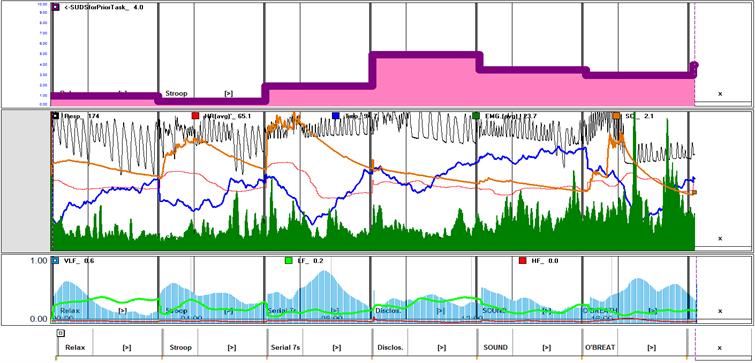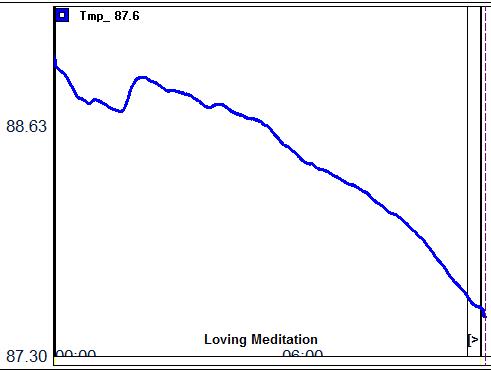
Stress Styles:
- Anticipation, Performance and Recovery Profilies
An Example
At 30 years of age, Robert has a very demanding job. And he needs the money he makes to help support his wife, who is off work for medical reasons. He feels overwhelmed.
Subjectively, he rated his highest distress at 5 of 10 during disclosure of an emotional issue. This reaction lingerered as well.
- Shoulder muscle tension went up across the session.
- Breathing was tense during and after the mental math challenge, and did not always show recovery, another sign of high reactivity.
-Importantly disclosure of personal weaknesses did not increase skin conductance or decrease finger temperature.
- Subtle heart rate changes were amplified by a computer algorithm and displayed as filled-in lines on the bottom of the graph. Robert's data showed signs of mild cardiac sympathetic dominance - bottom line - which indicated a tendency to for his heart rate to elevate when he ruminated during recoveries.
IMPRESSIONS
It is likely this person has difficulty letting go, and harbors tension in the shoulders and chest. He had no problems disclosing personal weaknesses. He performed cognitive and performance tasks well, and t=did not significantly ruminate afterwards.
RECOMMENDATIONS
He could benefit from a regular session of Mindfulness relaxation using biofeedback alarms that triggered when he mentally slips into a negative rumination.
3. Mindful Exercises Protocol
In this example, mindful concentration on love and self-acceptance was perceived as very calming, but physiological indicators suggest she was dissociating from her sensations as hands get cooler and muscle tension stays steady with occassional increases.
The client was instructed to move her upper body muscles here.

STRESS-REACTIVITY ASSESSMENT - UNCOVERING EMBODIED THOUGHTS
Stress reactivity can be productive or unproductive. It is normal for reactivity to decline soon after a stressful event is over. Reactivity that lingers almost always is triggered by embodied thoughts about perceived failure, frustration or anger. These elicit physiological reactions that can be detected by biofeedback devices and produce graphs like the one shown here.
NOTE: Stress reactivity is an important aspect of examining a stress profile. There are other features of the profile, like the self-rating of distress caused by that stressor wich will nt be covered here.
RESILIENCE TRAINING
The goal is to help a person to first find ways of staying calmer in the present.
The long-term goal is to increase resilience to come back from stressors more refreshed.
There a several techniques to aid in this process:
TOP-DOWN TECHNIQUES - like Cognitive Behavioral Therapy
BOTTOM-UP TECHNIQES like Paced Breathing Relaxation





